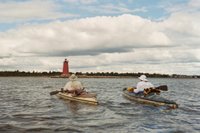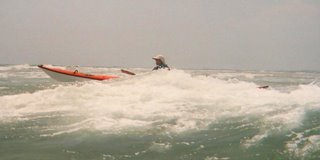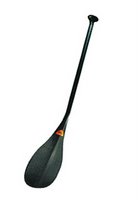I chose the Kruger Dreamcatcher for the UFC because everything I had read and researched, and saw, in my previous Everglades Challenges had me believing that a Kruger would be the driest and most comfortable boat to paddle, for 40 miles a day, everyday for 30 days, compared to a typical sea kayak. It's size also offered the additional bonus of letting me bike tow the portage rather than walk-tow the 40 miles.
Previous po sts on this blog about the Dreamcatcher include, "A Kruger and Me", excerpts from a trip report of a week long paddle on Lake Michigan with Mark Przedwojewski (owner and builder of Kruger Canoes). This was my introduction to the Dreamcatcher. "What's up with the Kruger?" is a posting that highlights parts of a review in Paddler Magazine's Nov/Dec 2005 issue on "Decked Touring and Tripping Canoes", which included a review of the Kruger Canoes.
sts on this blog about the Dreamcatcher include, "A Kruger and Me", excerpts from a trip report of a week long paddle on Lake Michigan with Mark Przedwojewski (owner and builder of Kruger Canoes). This was my introduction to the Dreamcatcher. "What's up with the Kruger?" is a posting that highlights parts of a review in Paddler Magazine's Nov/Dec 2005 issue on "Decked Touring and Tripping Canoes", which included a review of the Kruger Canoes.
The Challeng e ended. While training, I hadn't paddled my Explorer for 9 months. But I have been paddling it quite a bit since I've been back, and plan to spend the next 2 weekends on the coast playing with it in the surf. Then two weekends ago I had an incredible urge to get out and paddle my Dreamcatcher. It was a great Saturday on the lake, much like visiting with an old friend. My Explorer might be more playful for a few hours, but the Dreamcatcher surprises me all the time. It's such a great traveler, I can't wait to start planning some trips with it soon.
e ended. While training, I hadn't paddled my Explorer for 9 months. But I have been paddling it quite a bit since I've been back, and plan to spend the next 2 weekends on the coast playing with it in the surf. Then two weekends ago I had an incredible urge to get out and paddle my Dreamcatcher. It was a great Saturday on the lake, much like visiting with an old friend. My Explorer might be more playful for a few hours, but the Dreamcatcher surprises me all the time. It's such a great traveler, I can't wait to start planning some trips with it soon.
"The World's Top Canoe Expeditions", from Paddling Online May/June 2002, has a great article listing and describing the world's top canoe trips. It's well worth the short read. Almost all these expeditions include traveling the worlds Oceans, or our Great Lakes. Included among them are a couple of the the many expeditions paddled by Verlen Kruger (designer and founder of Kruger Canoes), including his Ultimate Canoe Challenge, 28,000 miles in 3 1/2 years.
Verlin, along with Steve Landick, paddled down the length of the Missouri River, up th e Illinois, across the Great Lakes and out into the Atlantic. They then paddled along the Eastern Seaboard, around the Florida Keys and along the Gulf Coast before paddling back up the Mississippi. They then reached the Arctic Ocean, paddled and portaged across Alaska, carrying their canoes and supplies over infamous Chilkoot Pass before descending to the Pacific Ocean. The Inside Passage was next, all the way down the west coast of North America and around the tip of the Baja Peninsula. They reached the mouth of the Colorado River then portaged up the Grand Canyon, they proceeded across the U.S. and Canada before returning to Michigan. This in Kruger Canoes.
e Illinois, across the Great Lakes and out into the Atlantic. They then paddled along the Eastern Seaboard, around the Florida Keys and along the Gulf Coast before paddling back up the Mississippi. They then reached the Arctic Ocean, paddled and portaged across Alaska, carrying their canoes and supplies over infamous Chilkoot Pass before descending to the Pacific Ocean. The Inside Passage was next, all the way down the west coast of North America and around the tip of the Baja Peninsula. They reached the mouth of the Colorado River then portaged up the Grand Canyon, they proceeded across the U.S. and Canada before returning to Michigan. This in Kruger Canoes.
And then there is always the "But can you roll it?" question. No, I can't, thought I am fairly skilled at rolling. Recently a very popular and very skilled award winning Greenland rolling instructor took an unexpected swim at my favorite play ground, Bougue Inlet. Leone Somme, 5*BCU paddler, swam during the Iceland Expedition with Shawna Franklin and Chris Duff. Nothing is guaranteed. Any really well trained sea kayaker knows it's not about your roll, but about your ability to rescue. The BCU4* and BCU5* training classes are not about rolling, but all about safety, decision making, rescue, and leadership.
I've actually found the Dreamcatcher to be a much more stable boat in rough water. There were many occasions during the UFC where I was in conditions that would have required bracing and good control in my Explorer, the Dreamcatcher didn't seem to notice. Of course I did take a swim in the Dreamcatcher when the Manatee flipped me.
Am I still happy and loving the Kruger? Absolutely!






No comments:
Post a Comment